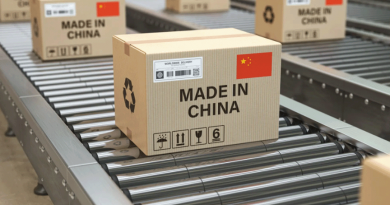Hope for the best, plan for the worst
Dr Graham Bright is the Head of Compliance and Operations at Euro Exim Bank
Having survived the rigors of Christmas, with panic buying now a distant memory, December saw a flurry of international trade activity, with deals signed between the UK and Australia, and digital trade deals with Singapore.
And rather than the expected lull in January activity, negotiations have commenced towards a free trade deal spanning 5 years between the UK and India. This cements a long-standing history of trade and investment, aimed to increase jobs and revenue in pharmaceuticals, leatherwear, textiles and footwear. Service sectors will also benefit in areas such as nursing, education and IT.
Additionally, the UK Department for international Trade has set its sights firmly on securing membership of the Comprehensive and Progressive Agreement for Trans-Pacific Partnership (CPTPP) by the end of 2022, giving access to trade worth USD13.5trillion. Known as TPP-11, the member nations span the Far East, Australasia and South America incorporating such powerhouses as Japan and Singapore.
With this positive step, the agreement aims clearly to increase economic security, enable non-tariff barriers to trade to be removed help to diversify trade links and re-position the UK as a true global hub following Brexit and the challenges brought by the pandemic.
And, by trading with nations already acting in different FTA’s, there should be even greater opportunities, markets and exchange of products and services, to fulfil the ambitions of all the member nations which in turn brings benefits and resources for people to work on problems that all nations are facing, in tech, the environment, healthcare and other sectors.
So, a rosy outlook to start the year. But, major challenges are still ahead, as the worlds’ second largest trading nation, China, with GDP larger than those of the next four economies – Japan, Germany, the United Kingdom, and India – combined, is facing a new reality when looking at sustainability of growth. Despite the intent, collaboration and reach of FTA’s, some countries are maintaining their protectionist, restrictive access, subsidy driven stance.
After its rapid rise, China growth rates have slowed, with the biggest factor being the fall in production in domestic markets, ageing population and reduced numbers of workers estimated to be in the region of 35 million over the next 5 years.
Just as the UK Government has acted to raise the retirement age and keep people in employment longer, China aims to do the same to preserve tax contributions with creation of new jobs.
The global appetite for Chinese goods is insatiable, and as a prime example, the UK imported £40.5 billion more from China than it exported to the country in the year to June 2021, a rise of imports from China of 38% increasing the trade surplus to over USD 670 billion.
In the same period, UK exports fell by 34%, a picture reflected in many other nations internationally.
China is set on promoting more self-sufficiency, greater domestic consumption and less reliance on the export market long term. But when things go wrong, the repercussions are immense as ‘debt bombs’ are created with companies ‘too big to fail’.
The Evergrande issue is ongoing, with unfulfilled debt obligations of USD 300 billion, hundreds of unfinished properties now classified as distressed assets, thousands of unpaid workers, millions of jobs at risk and loss of home buyers.
Closer to home, international trade is not quickly returning to pre-COVID levels or pricing. Just as forward transactions in currency markets may secure future prices, so contracts in shipping were agreed months ago at a time where exporters could negotiate prices with the luxury of excess capacity.
How different it all seems today.
Rates to move goods crossborder have never been higher, as contraction of supply chains has caused every player in the ecosystem of trade to review capacity. Starting with transport companies, prices are expected to double (not helped in the UK by additional demands for costly ow emission or electric vehicles, highest ever diesel prices at pumps and congestion charges).
The freight sector, handling the physical movement of goods is also impacted in areas of warehouse costs, displaced containers, ocean shipping and local logistics. And companies are still subject to market demand and the influence of a rapidly changing spot market on a short-term basis.
One example is the Brent crude oil price, at USD 55 per barrel one year ago is now standing at approximately USD 90, with predictions of USD 150 within three months.
In addition to containers being in the wrong place at the wrong time, with less overall capacity, we have already witnessed the staggering increase in spot prices for standard 40-foot containers, with prices up to 5 times higher than pre-pandemic levels and set to move higher still.
In some instances the cost of container transport even surpass the value of goods they contain, making it uneconomic and therefore impossible for smaller traders and niche businesses to sustain a healthy trade and cash flow.
We hope for the best outcome and plan for the worst. The next quarter will be critical
Looking at the other areas of logistics in the supply chain, the cost of warehousing, increase in demurrage fees (namely the charge that the merchant pays for the use of the container within the terminal beyond the free time period), labour costs, increased fuel costs and shortage of drivers to move goods will lead to inevitable price rises.
With such uncertainty and taking into account the rising costs (up 25% on average for leasing warehouse space, it is no surprise that companies are not prepared to lock in long term leases and taking the financial hit on shorter terms.
Whilst in the past the demand for goods at low price has meant shippers absorbing costs, the time has come where increases have become so common and of such magnitude that these costs must be passed on to consumers. Even using AI technology for innovating least cost routing, consolidating shipments, sharing containers and only renting delivery vehicles when required, the choice is stark.
Inflation is on the rise and consumers must pay more as shippers and other players in the global supply chain find themselves with drastically reduced margins, operating expenses and more pressure than ever to deliver at a price the consumer can afford.
But experts say companies have little choice other than absorbing the cost or passing it along to their customers.
Overall, transportation rarely exceeds more than 7% of the cost of goods being shipped. For most companies, the value of the product being sold and the importance of that sale is much greater than a slight increase in transportation costs.
Companies always want the cheapest route to the client, but will not want to compromise long terms trade and future customers if the only differentiator is the cost of delivery.
The next big thing? The rise, appeal and acceptance of crypto and asset tokenization. With banks providing loans as far back as in Babylon in 1,800 BC, and ‘modern’ banking coming about in the 1470s, banks have not been the fastest innovators.
However, the past 10 years has seen more advanced products and more adoption of disruptive technology than in the previous 100 years, where traditional bricks and mortar, large branch network, limited product financial institutions have given way to mobile, agile, multi-currency, e-banking, global, internet driven service providers.
And it is not only the service delivery method that has changed so dramatically, but the pace of change, sparked by the inclusive nature and tech-savvy social media generation demanding faster, more diverse, secure services.
The demand for data, information and financial services, and the technology to support vast data consumption now, has only been made possible by the advent of high-speed networks, smartphones and technology companies, translating those needs, enabling anyone, anywhere to trade international equities, bonds and derivatives, arrange a mortgage, make deposits, trade crypto currency, electronically sign and send vital documents, at the click of a button.
Whilst the past 20 years may be the era of internet banking, 2020 onwards has launched the decade of crypto.
As of January 2022, there were approximately 10,000 cryptocurrencies in existence, many created for specific purposes with solid use cases, and others as speculative investment tools with spectacular volatility, few investors and even less volume.
Always a case of buyer beware, some earlier coin offerings experienced bad press through hacking, loss of consumer confidence, no activity, price collapse and where the mere mention of blockchain sent the investment community into a frenzy.
And how times have changed, with much more consumer demand, as, like bond and equity offerings, new coins are coming to market via initial exchange and security token offerings following extended due diligence by the trading platform.
Cryptocurrency (especially Bitcoin) is no stranger to volatility. However, in the past, the equities markets have also produced spectacular returns and losses, albeit across different timelines and remain considered a safer haven than crypto markets
Whilst the 1929 Wall Street Crash witnessed significant falls such as RCA common stock from $505 to $26 and DuPont from $217 to $80), black swan events have also elevated stock markets. For example, Alcoa experienced 12 month returns of 217%, and risk averse long term portfolio holders have borne fruit with Monster, with shares at $2 in 2005, hitting $140 in 2015, and the darling of the equities market Amazon, with canny investors buying at $2 in the 1990s, where today they trade at $3,500.
Whilst equities still represent a more stable investment platform, crypto has captured a new imagination with a new demographic. With an almost baffling choice of cryptocurrencies, the key issue for investors will be the ability to seamlessly cash out of low volatility, low value stock and move in and out of fiat currency in deciding which type of coin best suits a long-term strategy.
So, with a requirement for a more stable, digital crypto instrument, the latest area of investor interest and some may say hype, is asset tokenisation. Blockchain technology remains the vital component, the mechanism and enabler to underpin crypto transactions.
In asset tokenization, digital tokens are used to fractionalize ownership of assets. Physical items are reflected on the blockchain which manages ownership rights – and anything from property to university degrees and from gold to stocks can be tokenised, with over USD 500 million already tokenized in real estate.
These tokens are created during a so-called STO (Security Token Offering), in which the real estate is essentially split up into digital, tradable assets stored on a blockchain.
The idea of fractional real estate ownership is nothing new. Since 1960, REITs (Real Estate Investment Trusts) were introduced in the United States and by pooling investors’ capital, the real estate market suddenly became much more accessible and makes it possible to invest in the underlying asset without having to buy or manage the entire property.
Fast forward to 2022 and the advent of more commercial tokenisation, where real estate is more readily fractionized into small pieces, namely tokens. What are the benefits?
Global increases in property prices, expensive and rising bank rates, less monetization opportunities, languishing assets earning low interest, high costs of ownership with less people able to afford current and future prices all of these can be managed, by fractionising and tokenization.
And as digital tokens on a blockchain can be securely and efficiently transferred without a middleman, trading of these asset-backed tokens suddenly becomes much easier and cheaper, leading to increased liquidity.
It’s easy to see why investors of all sizes are enthusiastic about this development. With a much lower market entry point with less initial investment, the global real estate market is valued at around $280 trillion, making it one of the largest, most illiquid, and non-transparent markets on earth.
And post pandemic, in an era of rising costs, there are many distressed assets where such an investment approach may provide an economic lifeline to owners, and competitive opportunities for smaller investors.
One can almost imagine the scenario where an investor might be able to increase their international holdings through the purchase two tokens in a block or apartments in Chennai, ten tokens of a factory in Malaysia, and three tokens of a flat in Hong Kong – all payable in coins, through a single platform.
Recognising this opportunity, Euro Exim Bank are investigating the tokenization of such assets and looking at offering several unique coins, asset backed by investment grade instruments in an easy to trade blockchain-based token.
Whilst the industry is always on the lookout for the next best thing, we believe the tokenisation projects will position the bank as a crypto provider of choice, with provenance, security, asset backing, assurance, and value.
In addition to our strategy on coins and tokens, our journey towards full digitisation of documents and digitalisation of processes across the extensive trade ecosystem continues apace.
Our lofty ambitions and aspirations are to be the premier provider of trade and crypto currency services through stable coins and tokens, contributing to better customer experience. With fast, crossborder payments, low transaction fees, efficient settlement, and management of platforms, we will facilitate access to distributed financial services for the unbanked, ultimately enabling digital financial inclusion.
At the time of writing, with the UK COVID wine and cake Partygate debacle seriously overshadowed by ongoing international tension as Russia invades Ukraine, fears abound of its longer-term intentions to extend its reach to re-establish a power bloc similar to the former multi-state Soviet Union.
The West will need to be mindful and fully prepared to deal with trade implications, sanctions, which have now started, repercussions in the event of invasion, NATO and European military support, and how to handle possible nation state cyber-attacks on all manner of businesses across the supply chain.
With such a fluid situation, whilst free trade agreements were supposed to bring unity, collaboration and increase in collective wealth, their purpose is clearly being eroded as former allies become enemies, and protectionism, nationalism and isolationism become the new order.
We hope for the best outcome and plan for the worst. The next quarter will be critical.




